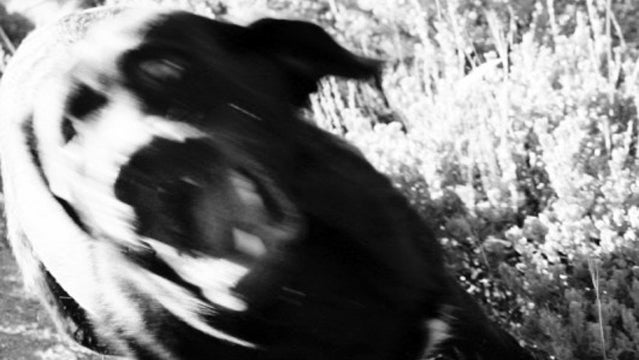At times, it seems like my dog Danger is trying to willfully unhinge me. Frantic outbursts, lunging for my arm and then dangling from it by his teeth, swiping sticks of butter off the counters and then swallowing them whole like horse pills—these are all par for the course. Getting a dog to not do something can often be harder than teaching complicated behaviors. Most guys I know resort to some combination of shouting, “Cut that $@&# out!” and the dog’s name over and over. I’m guilty of this, too, though less now than I used to be. Here’s a primer on what works and what doesn’t.
The Ultimate �����ԹϺ��� Companion
All you need to know about going wild with man’s best friend.WHAT TO DO
1. First, figure out what’s setting the dog off. In my case, the big problem has been his going crazy and lunging at me during field training. Yeah, that seems like the big problem, but, really, what he’s doing is trying to avoid structured training. Sometimes it’s easy to figure out what’s setting him off, like when he barks bloody murder whenever someone knocks at the door. Other times, it’s harder. In any case, try to figure it out and know that it could be something as subtle as the way you lean over him before signaling a retrieve.
2. Decide on an alternate behavior to replace the unwanted behavior with. For the door knocking problem, Sue is having me train Danger to go to his dog bed and sit rather than race toward the door. For other annoying episodes like barking, greeting strangers or strange dogs on walks, and sniffing when he should be heeling, eye contact is generally the best swap.
3. We’ll start with the eye contact swap and save the door rushing (harder by a long shot) for another time. The command that most people use to mean, “Stop whatever it is you’re doing—raiding, looting, humping—and look at me,” is “Leave it.”
Sue had me start by holding a treat out to my side in my right hand and a clicker and another treat in my left. Danger sniffed my closed right hand, tried to mouth it, and, finally, when he gave up and made eye contact with me, I clicked and gave him the treat from the left hand. It only took one or two tries for him to realize that trying to gnaw the treat out of my fist wouldn’t work, but that making eye contact would be immediately rewarded. The clicker speeds this process up drastically by marking that exact moment when he makes eye contact as the thing that earned the treat. Now it’s just a matter of slowly upping the level of distraction: First with a treat under my foot that I could step on if he dove for it, then dropping treats in front of him. When Danger was successful about 80 percent of the time in making eye contact when I dropped a treat in front of him, we added the cue, “Leave it.”
NOTE: “Leave it” is not a punishment. You don’t shout it or growl it; just say it matter-of-fact like. (This is actually really difficult when he’s dragging you toward another dog on a walk.)
4. Now, with your new command, you’ll need to train him with the specific problems you’re having. If you want him to ignore other dogs on walks, you’ll have to train with another dog. For this, I give Danger a preemptive “Leave it” as the other dog approaches. He’s got to turn away from the other dog and make eye contact to get a reward. By this point, he knows exactly what is required to get a treat, it’s just a question of whether pulling toward the other dog is worth more than a treat in his doggy brain. If it isn’t, I’ll lower my expectations and increase the distance to the other dog until he’s getting it right every time. The goal with this, as with all training, is for the dog to be successful at least 80 percent of the time.
5. You may still encounter situations that are too enticing for your dog to ignore. Yes, physically remove your dog if you need to, but, no, don’t get mad at him. You just need more training for higher levels of distraction. The worst thing you can do is repeatedly shout “Leave it.” Doing this will only weaken the meaning of the command.
6. Now the harder part: unwanted behaviors that aren’t caused by obvious things like approaching people and dogs. My specific problem is a playful lunging that quickly escalates to growling and biting. First, I’ve got to remove whatever stimulus is setting him off. It turns out that trying to overpower him, which is both doable and tempting with an otherwise sweet 60-pound Lab, is a big-time stimulus. When I do this, he only accelerates until I’m bleeding and we look like one of those cartoon dust balls with paws and arms occasionally flying out of it. Instead, I force myself to stay dead still and say “Leave it” one time. He’ll usually keep it up for a few seconds, aiming for an arm or flap of clothing, and then quit, sit, and make eye contact. Then I mark the behavior and give him a treat or praise.
NOTE: My hunting buddies think that allowing the dog to disrespect me this way is crazy. Maybe, but it’s going to keep us both out of the emergency room.
WHAT NOT TO DO
1. In general, trying to force the dog to do anything is going to set that arrangement as a precident. See another dog coming and you yank one way on the leash and he yanks the other? That’s how it’s always going to be.
2. The old rub his nose in … [pick one] turd, steak, trash and shouting “No!” OK, on second thought, it’ll probably still make you feel a lot better, even if it doesn’t teach him a thing. Go ahead and shout “No,” just once, and then throw him outside. No rubbing his nose in it, though. You’ll feel bad once your need for revenge has passed.
3. Drive your knee into a dog that’s jumping up. This one’s still surprisingly common among a lot of trainers for one simple reason: when a dog is jumping at you, fending him off with your knee is often the first instinct. It was with me, even before I heard about it as an actual technique. It was also one of the factors that led to my current problems with Danger lunging at me. From my limited experience, it’s better to save your sharp knees for the Octagon than explain yourself to horrified onlookers and risk hurting your best friend.
4. This applies to everything in dog training (and life): Don’t lose your cool. It’s really easy to do when Danger is tearing off down the street, but I force myself not to chase after him or repeatedly shout his name. Whatever the problem is, break it down into small pieces and train it out methodically.
This article originally appeared on �����ԹϺ��� K9, the former dog blog of �����ԹϺ��� magazine, on April 3, 2009.


